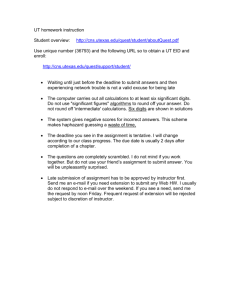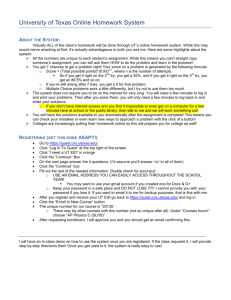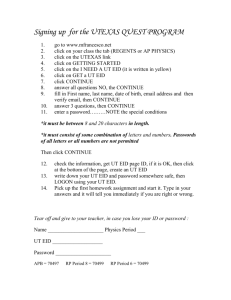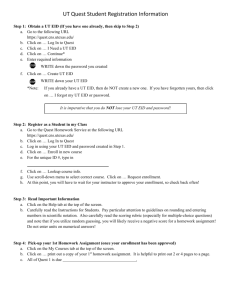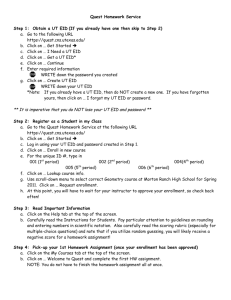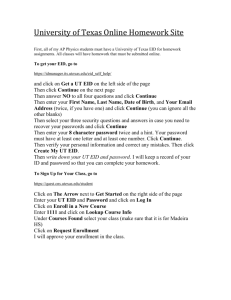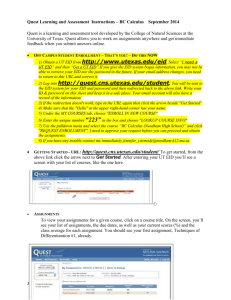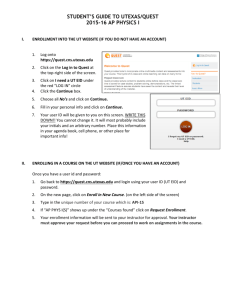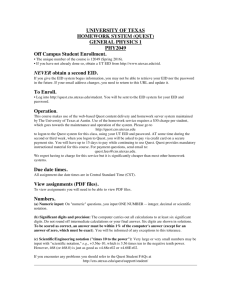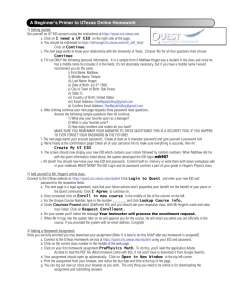UT homework instruction
advertisement
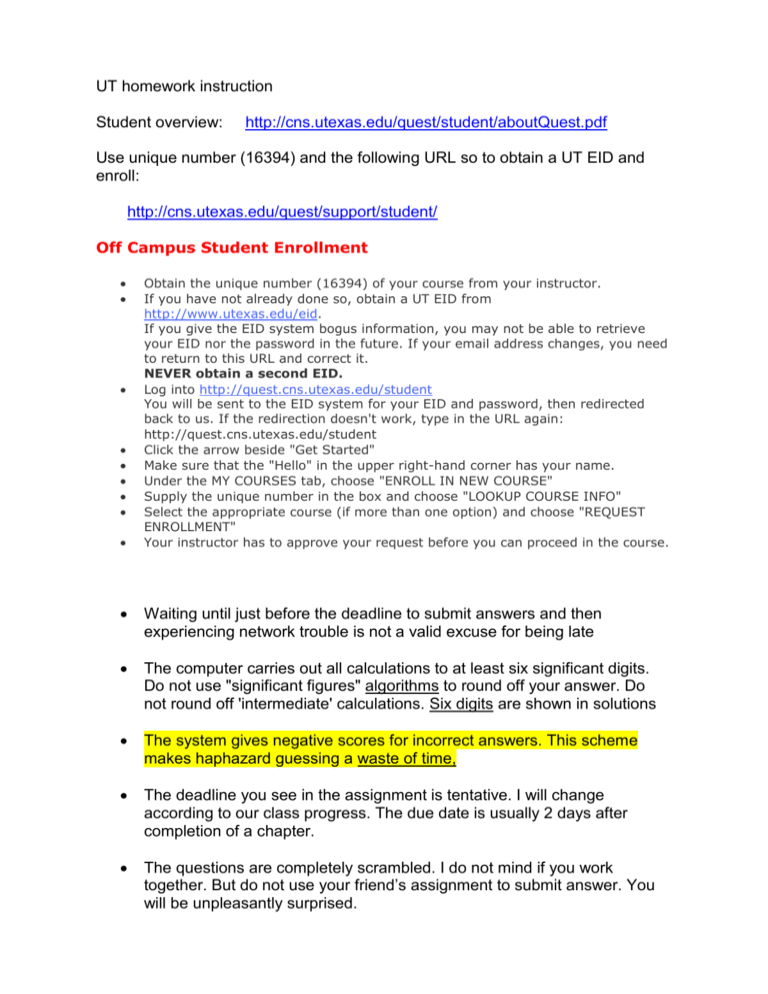
UT homework instruction Student overview: http://cns.utexas.edu/quest/student/aboutQuest.pdf Use unique number (16394) and the following URL so to obtain a UT EID and enroll: http://cns.utexas.edu/quest/support/student/ Off Campus Student Enrollment Obtain the unique number (16394) of your course from your instructor. If you have not already done so, obtain a UT EID from http://www.utexas.edu/eid. If you give the EID system bogus information, you may not be able to retrieve your EID nor the password in the future. If your email address changes, you need to return to this URL and correct it. NEVER obtain a second EID. Log into http://quest.cns.utexas.edu/student You will be sent to the EID system for your EID and password, then redirected back to us. If the redirection doesn't work, type in the URL again: http://quest.cns.utexas.edu/student Click the arrow beside "Get Started" Make sure that the "Hello" in the upper right-hand corner has your name. Under the MY COURSES tab, choose "ENROLL IN NEW COURSE" Supply the unique number in the box and choose "LOOKUP COURSE INFO" Select the appropriate course (if more than one option) and choose "REQUEST ENROLLMENT" Your instructor has to approve your request before you can proceed in the course. Waiting until just before the deadline to submit answers and then experiencing network trouble is not a valid excuse for being late The computer carries out all calculations to at least six significant digits. Do not use "significant figures" algorithms to round off your answer. Do not round off 'intermediate' calculations. Six digits are shown in solutions The system gives negative scores for incorrect answers. This scheme makes haphazard guessing a waste of time, The deadline you see in the assignment is tentative. I will change according to our class progress. The due date is usually 2 days after completion of a chapter. The questions are completely scrambled. I do not mind if you work together. But do not use your friend’s assignment to submit answer. You will be unpleasantly surprised. Late submission of assignment has to be approved by instructor first. Send me an e-mail if you need extension to submit any Web HW. I usually do not respond to e-mail over the weekend. If you foresee a need, send me the request by noon Friday. Frequent request of extension will be rejected subject to discretion of instructor. Scoring a) Multiple-choice questions A randomly guessing student should, on average, receive the same score as a student who does not answer. Our multiple-choice scoring scheme corrects for random guessing by giving negative scores for incorrect answers. (The SAT does this also.) This scheme makes haphazard guessing a waste of time, which will not improve (or help) a student's score over the long run. If students are not sure of the correct answer, but they can eliminate one or more of the choices as wrong, they increase their chances of selecting the correct answer. Statistically, it is to their advantage to answer such a question. The table below illustrates how the neutral scoring scheme works for a +10.00 point question. The table is subdivided into three blocks, which represent the number of choices for a particular multiple choice question: Block 1 (10 choices); Block 2 (6); and Block 3 (3 choices). Each block includes three columns: Try represents the number of times a question is attempted; Correct represents the question score if answered correctly on this particular attempt; and Incorrect represents the question score if answered incorrectly on this and all previous attempts. For example, when you select the correct choice on the first try, you receive full credit; a score of +10.00. If your answer is incorrect (on a 10 option question), however, you are penalized and you receive a negative score of -1.11 (at least until you try again). Question with 10 choices Question with 6 choicesQuestion with 3 choices Try Correct Incorrect Try CorrectIncorrect Try CorrectIncorrect 1 +10 -1.11 1 +10 -2 1 +10 -5 2 +7.78 -2.22 2 +6 -4 2 0 -10 3 +5.56 -3.33 3 +2 -6 4 +3.33 -4.44 4 -2 -8 5 +1.11 -5.56 5 -6 -10 6 -1.11 -6.67 7 -3.33 -7.78 8 -5.56 -8.89 9 -7.78 -10 b) Numeric questions using web submission For more than one try, the full credit score is multiplied by 0.93 ^ (t - 1), where "t" is the number of tries that you use, and the "^" is notation for "to the power of." (Note: 0.93 ^ 0 = 1.)
